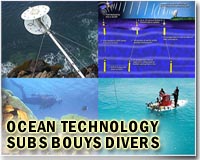 |
Miami FL (SPX) Feb 28, 2011 University of Miami (UM) Rosenstiel School of Marine and Atmospheric Science faculty were part of an international scientific team to show that strong links between the corals reefs of the South China Sea, West Pacific and Coral Triangle hold the key to preserving fish and marine resources in the Asia-Pacific region. Rosenstiel School researchers Drs. Claire Paris and Robert Cowen and colleagues from the ARC Centre of Excellence for Coral Reef Studies at James Cook University and University of California - Los Angeles, have established that the richest marine region on Earth - the Coral Triangle between Indonesia, Malaysia and the Philippines - depends vitally for its diversity and resilience on coral and fish larvae swept in from the South China Sea and Solomon Islands. "By evaluating the directionality of larval transport over multiple generations, we could describe the signature of the extraordinary genetic diversity of the Coral Triangle. Preserving diversity is key to the health of marine systems," said Claire Paris, Rosenstiel School assistant professor of Applied Marine Physics. "This kind of work will help us anticipate and manage changes of connectivity networks in the future." The authors provide evidence showing the regions' biology is closely inter-connected suggesting that it is in the interests of all Asia-Pacific littoral countries to work together more closely to protect it. "Maintaining the network of links between reefs allowing larvae to flow between them and re-stock depleted areas, is key to saving coral ecosystems threatened by human pressure and climate change," said the paper's lead author Johnathan T. Kool of James Cook University, who is also an alumnus of UM. "The science shows the region's natural resources are closely interconnected. Nations need to cooperate to look after them - and that begins with recognizing the resources are at risk and that collective action is needed to protect them." The Coral Triangle is home to more than one third of all the world's coral reefs, including over 600 different species of reef-building coral and 3,000 species of reef fish. These coral ecosystems provide food and income for more than 100 million people working in marine-based industries throughout the region. Six nations within the Coral Triangle - Indonesia, the Philippines, Malaysia, Papua New Guinea, The Solomon Islands and Timor L'Este - are now working together to strengthen coral reef governance and management, under an arrangement known as the Coral Triangle Initiative. The paper, titled "Connectivity and the development of population genetic structure in Indo-West Pacific coral reef communities" by Johnathan T. Kool, Claire B. Paris, Paul H. Barber and Robert K. Cowen is available online and will be published in the March issue of the journal Global Ecology and Biogeography.
Share This Article With Planet Earth
Related Links University of Miami Rosenstiel School of Marine and Atmospheric Science Water News - Science, Technology and Politics
 Research helps Hawaii produce exports
Research helps Hawaii produce exportsWashington (UPI) Feb 25, 2011 Hawaii growers say they can now export more fruits and vegetables to the U.S. mainland thanks to research by agricultural scientists. Tropical fruits and vegetables such as papaya, rambutan, longan, dragon fruit and purple-fleshed sweet potato are gaining popularity across the United States but have faced hurdles of strict quarantine restrictions and sanitary measures to keep agricultur ... read more |
|
| The content herein, unless otherwise known to be public domain, are Copyright 1995-2010 - SpaceDaily. AFP and UPI Wire Stories are copyright Agence France-Presse and United Press International. ESA Portal Reports are copyright European Space Agency. All NASA sourced material is public domain. Additional copyrights may apply in whole or part to other bona fide parties. Advertising does not imply endorsement,agreement or approval of any opinions, statements or information provided by SpaceDaily on any Web page published or hosted by SpaceDaily. Privacy Statement |